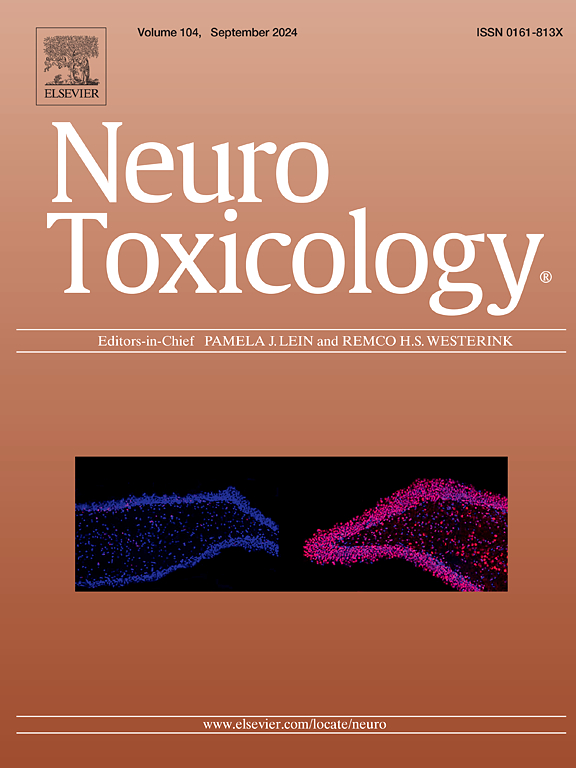Severe neurotoxicity induced by the combined exposure to cadmium and high-fat diet: Protective role of naringin against oxidative, mitochondrial, and inflammatory brain damage
IF 3.9
3区 医学
Q2 NEUROSCIENCES
引用次数: 0
Abstract
Environmental cadmium (Cd) contamination has increased in recent years, coinciding with the expansion of industrial activities and the global consumption of high-fat diets (HFD). Both are recognized as independent risk factors for neurodegenerative processes, yet their combined effects on brain function remain poorly characterized. This study is the first to investigate the interactive neurotoxicity of chronic Cd exposure and HFD, and to assess the potential protective effects of naringin, a flavonoid with known antioxidant and anti-inflammatory properties. Eighty female NMRI mice were assigned to eight groups receiving low- or high-fat diets, with or without Cd (0.5 or 5 ppm) in drinking water for 12 weeks. Two groups co-exposed to Cd and HFD received naringin (50 or 100 mg/kg). Behavioral assessments (Y-maze, shuttle box) were conducted, along with evaluations of oxidative stress markers, mitochondrial function, acetylcholinesterase activity, DNA fragmentation, histopathology, and proinflammatory cytokines. Cd and HFD individually induced cognitive deficits, oxidative imbalance, mitochondrial dysfunction, inflammation, and cholinergic disruption, which were more pronounced when both insults were combined. Naringin, particularly at a dose of 100 mg/kg, effectively reversed these alterations, restoring redox homeostasis and neuronal integrity without reducing Cadmium accumulation in brain tissue. These findings demonstrate, for the first time, that naringin mitigates the synergistic neurotoxic effects of Cd and HFD, highlighting its therapeutic potential against modern environmental and dietary challenges.
镉和高脂肪饮食联合暴露引起的严重神经毒性:柚皮苷对氧化性、线粒体和炎症性脑损伤的保护作用
近年来,随着工业活动的扩大和全球高脂肪饮食的消费,环境镉污染有所增加。两者都被认为是神经退行性过程的独立危险因素,但它们对脑功能的综合影响仍不清楚。这项研究首次研究了慢性Cd暴露和HFD的相互作用神经毒性,并评估了柚皮苷(一种已知具有抗氧化和抗炎特性的类黄酮)的潜在保护作用。80只雌性NMRI小鼠被分为8组,分别接受低脂肪或高脂肪饮食,饮用水中含有或不含镉(0.5或5 ppm),持续12周。同时暴露于Cd和HFD的两组给予柚皮苷(50或100 mg/kg)。进行行为评估(y形迷宫、穿梭箱),同时评估氧化应激标志物、线粒体功能、乙酰胆碱酯酶活性、DNA片段化、组织病理学和促炎细胞因子。Cd和HFD分别诱导认知缺陷、氧化失衡、线粒体功能障碍、炎症和胆碱能紊乱,当两种损伤联合使用时,这些症状更为明显。柚皮苷,特别是在100 mg/kg的剂量下,有效地逆转了这些改变,恢复氧化还原稳态和神经元的完整性,而不减少镉在脑组织中的积累。这些发现首次表明,柚皮苷减轻了Cd和HFD的协同神经毒性作用,突出了其对抗现代环境和饮食挑战的治疗潜力。
本文章由计算机程序翻译,如有差异,请以英文原文为准。
求助全文
约1分钟内获得全文
求助全文
来源期刊

Neurotoxicology
医学-毒理学
CiteScore
6.80
自引率
5.90%
发文量
161
审稿时长
70 days
期刊介绍:
NeuroToxicology specializes in publishing the best peer-reviewed original research papers dealing with the effects of toxic substances on the nervous system of humans and experimental animals of all ages. The Journal emphasizes papers dealing with the neurotoxic effects of environmentally significant chemical hazards, manufactured drugs and naturally occurring compounds.
 求助内容:
求助内容: 应助结果提醒方式:
应助结果提醒方式:


